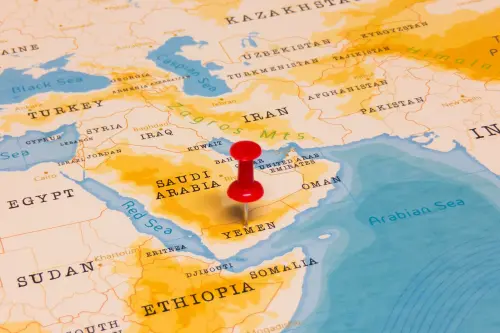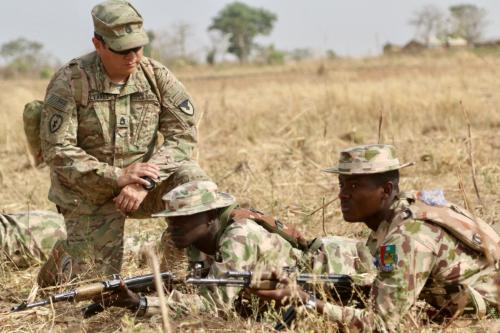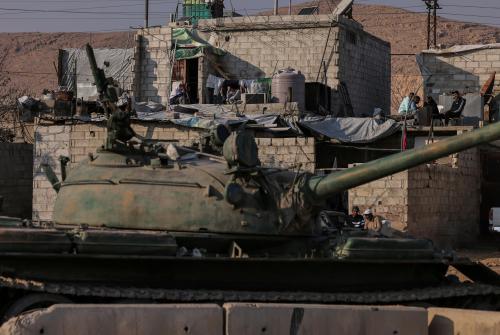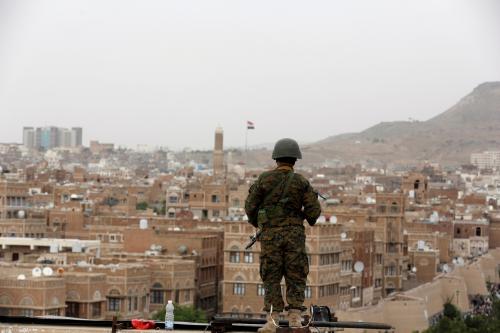The Houthis—a minor armed group from Yemen—have succeeded in upending global maritime commerce through the Red Sea, driving up the cost of goods globally and dampening global GDP, including in the United States. And there is little the United States can do about it. The United States is battling the Houthis in what officials have called the largest naval battle since World War II, but the Houthi threat is only increasing.
It is an important time to ask how we got here.
While the United States has few good options now, it could have helped prevent the war that propelled the Houthis to power and devastated Yemen. And doing so would have been far easier and less costly than battling the current Houthi threat. So why did the United States fail to do so?
In a new research paper, “How the United States could have prevented the Yemen War,” I identify three windows of opportunity between 2011 and 2015 when the United States could have prevented or mitigated the Yemen war. I describe the specific policy actions the United States could have taken during this period, while being clear-eyed about the limitations both of U.S. influence inside of Yemen and within the U.S. policy space.1 More importantly, I explore what U.S. failures in Yemen tell us about how the United States could improve its ability to prevent similar conflicts going forward and whether current reform efforts are sufficient.
Yemen is a compelling case study for two reasons: 1) the United States had a strong interest in and the ability to prevent the war; in fact, dozens of the policymakers in place in 2015 when the war broke out published a public letter acknowledging the U.S. policy failures, including President Barack Obama’s national security advisor; 2) Yemen is one of a growing number of “internationalized” wars—internal wars with significant international involvement—that have proven particularly destabilizing and difficult to resolve.
Missed opportunities
I find that the United States had three windows of opportunity to prevent or mitigate the Yemen war between 2011-2015:
2011
The United States could have used sanctions and a travel ban to secure stronger conditions on former Yemeni president/dictator Ali Abdullah Saleh after a popular, military-backed protest movement pushed him out of power in 2011. This would have prevented him from backing the Houthis to overthrow Yemen’s political transition process.
- Observed events: The United States, led by senior White House officials, supported a transition agreement under which Saleh was allowed to stay in Yemen, remain the head of the country’s dominant political party, and retain the billions he amassed while in power.
- Counterfactual causal chains and assumptions: Absent Saleh’s support, it is highly unlikely the Houthis could have seized the capital or other significant territory. Saleh was highly vulnerable to both sanctions and a travel ban in summer 2011, and the United States, in coordination with Saudi Arabia, could have credibly threatened these actions to secure Saleh’s cooperation with stricter terms (e.g., exile) that would have significantly restrained his ability to support the Houthis.
- Why the United States failed to seize the opportunity: Senior White House officials were aware Saleh posed a serious threat to the transition process but were hesitant to take actions that could disrupt high-priority U.S. counterterrorism activities (Saleh’s family members continued to oversee Yemen’s counterterrorism forces). Further, securing regional and international support for tougher conditions on Saleh would have required strong U.S. diplomatic leadership at a time when senior U.S. policymakers were overwhelmed dealing with instability across the Middle East.
2014
The United States could have used its considerable leverage with former Yemeni President Abd Rabbu Mansour Hadi to dissuade him from pursuing a plan for a future federal Yemen state that was unrealistic and put him in direct conflict with the Houthis following their takeover of the capital, a conflict which ultimately triggered the outbreak of the war.
- Observed events: Hadi pushed through a federal plan that intentionally sought to erode Houthi political and economic power, despite the fact that Hadi lacked the strength to enforce such a plan. The Houthis responded by placing Hadi and his cabinet under house arrest in January 2015. After Hadi escaped, the Saudi-led coalition launched a major military campaign against the Houthis.
- Counterfactual causal chains and assumptions: After taking control of the capital in September, the Houthis gradually asserted control of government institutions but were hesitant to topple the government, as doing so would jeopardize the legitimacy of a government they were effectively controlling. If the United States had pushed Hadi to pursue a more viable plan, Yemen could have avoided a major escalation, preserving space for U.N.-led negotiations to reach a new political equilibrium. While this scenario would have formalized Houthi power within the government, the political space prior to the war would have permitted significant constraints on Houthi power and behavior.
- Why the United States failed to seize the opportunity: It should have been clear to the United States that Hadi would lose in a confrontation with the Houthis, especially by September 2014, when the Houthis seized control of the capital with almost no resistance. However, the United States failed to update its assumptions about the Houthis and the status of the transition process, even in the face of overwhelming evidence.
2015
The White House could have made its support for the Saudi-led military campaign contingent on the Saudis identifying a credible end goal and path to negotiations. While the United States was unable to prevent the war at this stage, this approach could have facilitated an early transition to negotiations, significantly limiting the scope and duration of the conflict.
- Observed events: The United States provided unqualified support to the Saudi campaign and backed a U.N. Security Council resolution calling for a full Houthi surrender, which complicated U.N.-led negotiation efforts for years.
- Counterfactual causal chains and assumptions: Saudi dependence on U.S. diplomatic and military support provided the United States with leverage to shape the Saudi approach and objectives, particularly before they publicly announced the campaign. The United States was likely unable to dissuade the Saudis from launching the campaign, and concerns over the Saudi-U.S. bilateral relationship and priorities like the Iran nuclear deal prevented the United States from outright refusing to support the campaign. However, the United States could have used its leverage to convince Saudi Arabia to moderate its maximalist objectives and identify a pathway to negotiations without jeopardizing these other priorities. This could have facilitated an earlier transition to negotiations, especially after the Saudi-led coalition made significant military gains in mid-2015.
- Why the United States failed to seize the opportunity: U.S. policymakers, including Obama’s CIA director, knew at the time that the Saudi campaign plan was not viable, but officials failed to weigh the consequences for Yemeni stability alongside immediate U.S. policy imperatives like the Iran nuclear deal and U.S.-Saudi bilateral relationship. A persistent wishful thinking bias and the lack of strategic planning in the lead-up to the Saudi request exacerbated this failure.
Learning from U.S. failures in Yemen
The U.S. failure to seize these windows of opportunity was the result of systemic impediments to effective preventative action, including:
- The challenge of weighing the medium-term consequences of a policy decision alongside short-term costs.
- An adaptability challenge, namely the difficulty of updating U.S. assumptions in a sufficiently timely manner during dynamic periods, even in the face of overwhelming evidence, in part due to a “wishful thinking” bias.
- Insufficient high-level attention and bandwidth dedicated to Yemen even during periods of crisis, which compounded the adaptability challenge by undermining decisive U.S. policy action.
At no point were U.S. policymakers faced with an easy opportunity to prevent the Yemen war. To seize these fleeting windows of opportunity, officials would have had to accept tough truths and trade-offs and quickly mobilize resources. The U.S. ability to prevent conflict has always hinged on U.S. policy decisions, not how Washington wielded individual foreign policy tools like foreign assistance. Overcoming these systemic impediments to taking preventative action and seizing windows of opportunity would require significant reforms to elevate conflict prevention and make policymaking processes in countries at risk of conflict more adaptive and responsive.
The United States has reasserted its commitment to conflict prevention during the past 10 years, but it has failed to effectively address these policymaking challenges. The 2019 Global Fragility Act (GFA), the most significant and recent U.S. conflict prevention initiative, represents the culmination of years of efforts to learn from U.S. policy failures in fragile and conflict-affected countries and seeks to support long-term, whole-of-government investments in select countries. But the GFA has operated largely as a foreign assistance initiative and lacks the tools and authorities to influence the policymaking processes and decisions that are at the core of the U.S. ability to prevent conflict. While the GFA’s focus on learning could theoretically help address the adaptability challenge noted above, the initiative is primarily focused on long-term lessons for improving foreign assistance and the tools it has developed are not appropriate for informing real-time decisions of policymakers in rapidly changing environments.
In another new paper, “Implementing prevention: A practical guide for improving the U.S. approach to violent conflict in a changing world,” I provide a model for crafting a more effective approach that focuses on establishing more adaptive, responsive policymaking processes in strategically relevant countries with a near- to medium-term risk of conflict, building policymaker buy-in, and arming officials with the appropriate resources and incentives to prioritize prevention.
-
Acknowledgements and disclosures
The views expressed in this article are the author’s own, and not necessarily those of the U.S. government.
-
Footnotes
- Any counterfactual assessment is difficult, but I rely on a model developed by Jack Levy to ensure my counterfactuals stick as close to observed events and causal relationships as possible, are consistent with the conditions and information available to policymakers at the time, are logically consistent, and consider redirects toward conflict. See: Jack S. Levy, “Counterfactuals, Causal Inference, and Historical Analysis,” Security Studies 24, no. 3 (July 3, 2015): 378-402, https://doi.org/10.1080/09636412.2015.1070602.
The Brookings Institution is committed to quality, independence, and impact.
We are supported by a diverse array of funders. In line with our values and policies, each Brookings publication represents the sole views of its author(s).







Commentary
Learning from the United States’ failure to prevent the Yemen war
September 18, 2024